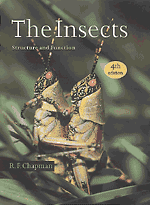Book contents
- Frontmatter
- Contents
- Preface
- Acknowledgments
- PART I The Head, Ingestion, Utilization and Distribution of Food
- PART II The Thorax and Locomotion
- PART III The Abdomen, Reproduction and Development
- PART IV The Integument, Gas Exchange and Homeostasis
- PART V Communication
- 20 Nervous system
- 21 Endocrine system
- 22 Vision
- 23 Mechanoreception
- 24 Chemoreception
- 25 Visual signals: color and light production
- 26 Mechanical communication: producing sound and substrate vibrations
- 27 Chemical communication: pheromones and chemicals with interspecific significance
- Taxonomic index
- Subject index
24 - Chemoreception
Published online by Cambridge University Press: 05 June 2012
- Frontmatter
- Contents
- Preface
- Acknowledgments
- PART I The Head, Ingestion, Utilization and Distribution of Food
- PART II The Thorax and Locomotion
- PART III The Abdomen, Reproduction and Development
- PART IV The Integument, Gas Exchange and Homeostasis
- PART V Communication
- 20 Nervous system
- 21 Endocrine system
- 22 Vision
- 23 Mechanoreception
- 24 Chemoreception
- 25 Visual signals: color and light production
- 26 Mechanical communication: producing sound and substrate vibrations
- 27 Chemical communication: pheromones and chemicals with interspecific significance
- Taxonomic index
- Subject index
Summary
Stimulation by chemicals involves the senses of smell (olfaction) and taste (gustation). Olfaction implies the ability to detect compounds in the gaseous state. Taste, in humans, refers to detection of compounds in solution, or in a liquid state, by receptors in the oral cavity. Insects have comparable receptors on many parts of the body, often using them for purposes unrelated to feeding, and they also have the ability to detect chemicals on dry surfaces as well as in solution. For these reasons, it is usual to refer to ‘contact chemoreception’ in insects rather than ‘taste’. The distinction between olfaction and contact chemoreception is usually clear, although olfactory receptors can respond to substances in solution and contact chemoreceptors respond to high concentrations of some odors. Processing within the central nervous system is, however, quite different. The axons from all olfactory receptors terminate in the antennal lobes in the brain (section 20.4.2) whereas axons from contact chemoreceptors terminate within the ganglion of the body segment on which the receptors occur.
Reviews: Frazier, 1992 – chemoreceptor physiology; Morita & Shiraishi, 1985 – chemoreceptor physiology; Payne, Birch & Kennedy, 1986 – olfaction
OLFACTION
Structure of receptors
Olfactory sensilla comprise cuticular and cellular components comparable, in a general sense, to those of cuticular mechanoreceptors and contact chemoreceptors (Fig. 24.1, and compare Figs. 23.1, 24.8).
Review: Zacharuk, 1985
Cuticular components The cuticle of olfactory receptors is characterized by the presence of numerous small pores which permit the entry of chemicals (Figs. 24.1, 24.2).
Information
- Type
- Chapter
- Information
- The InsectsStructure and Function, pp. 636 - 654Publisher: Cambridge University PressPrint publication year: 1998
Accessibility standard: Unknown
Why this information is here
This section outlines the accessibility features of this content - including support for screen readers, full keyboard navigation and high-contrast display options. This may not be relevant for you.Accessibility Information
- 1
- Cited by
